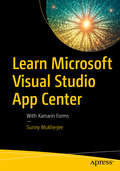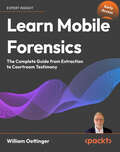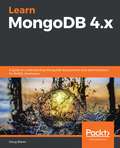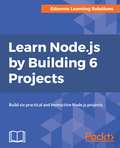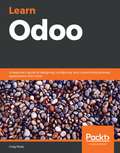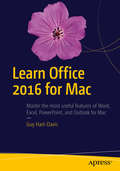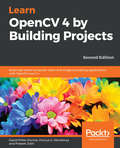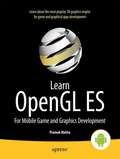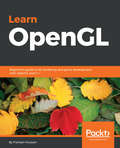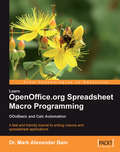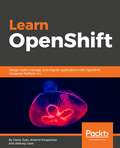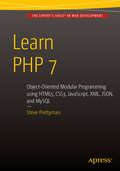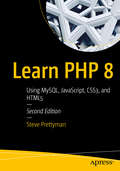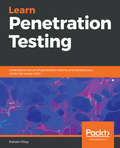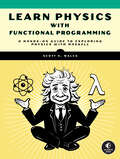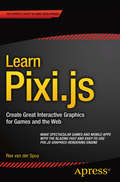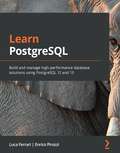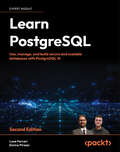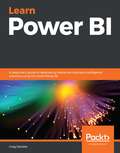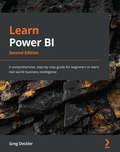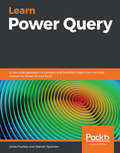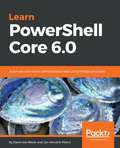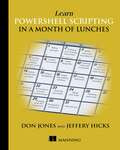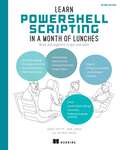- Table View
- List View
Learn Microsoft Project 2019: Streamline project, resource, and schedule management with Microsoft's project management software
by Srikanth ShirodkarExplore detailed explanations and examples to get up and running with the five phases of the project management lifecycle and integrate project management principles in a variety of projects Key Features Explore various algorithms and the latest features of MS Project to organize and keep track of your projects Understand Work Breakdown Structure (WBS) to improve productivity Apply real-world best practices and discover the tips, tricks, and pitfalls of schedule management Book Description Microsoft Project is one of the most popular project management tools for enterprises of all sizes thanks to its wide variety of features such as project scheduling, project budgeting, built-in templates, and reporting tools. Learning Microsoft Project 2019 will get you started with the basics and gradually guide you through the complete project life cycle. Starting with an overview of Microsoft Project 2019 and a brief introduction to project management concepts, this book will take you through the different phases of project management – initiation, planning, execution, control, and closure. You will then learn how to identify and handle problems related to scheduling, costing, resourcing, and work allocation. Understand how to use dynamic reports to create powerful, automated reports and dashboards at the click of a button. This Microsoft Project book highlights the pitfalls of overallocation and demonstrates how to avoid and resolve these issues using a wide spectrum of tools, techniques, and best practices. Finally, you will focus on executing Agile projects efficiently and get to grips with using Kanban and Scrum features. By the end of this book, you will be well-versed with Microsoft Project and have the skills you need to use it effectively in every stage of project management. What you will learn Create efficient project plans using Microsoft Project 2019 Get to grips with resolving complex issues related to time, budget, and resource allocation Understand how to create automated dynamic reports Identify and protect the critical path in your project and mitigate project risks Become well-versed with executing Agile projects using MS Project Understand how to create custom reports and make them available for future projects Who this book is for If you use Microsoft Office and are looking to use MS Project to manage your projects efficiently, this book is for you. Project managers or anyone interested in project management will also find this book useful. Basic knowledge of Windows UI and MS Office products is required.
Learn Microsoft Visual Studio App Center: With Xamarin Forms
by Sunny MukherjeeUse Visual Studio App Center with Xamarin Forms to set up a DevOps CI/CD pipeline, set up your mobile builds on either iOS or Android, set up Android and Apple certificates and provisioning profiles, distribute your app to your developers and testers, capture analytics and crashes from your users, communicate to your users with push notifications, and run UI tests on the Microsoft cloud. You will see how to automate and manage the life cycle of your apps through Microsoft's Cloud Service, with a focus on integrating App Center into your Xamarin Forms apps with clear, practical examples. As you follow along with the sample app, you will see how easy it is to configure your builds, to test the sample app on various iOS and Android devices on the App Center cloud, and to distribute your app to real devices. Whether you are a developer on a small team or a startup or an architect in a large organization curious about the benefits of Visual Studio App Center, after finishing this book, you will be confident in setting up App Center on your next mobile project. Come join me on this journey through Visual Studio App Center with Xamarin Forms.What You Will LearnCreate a DevOps CI/CD pipeline for your mobile app on both iOS and Android devicesSave money without buying multiple iOS and Android devices and instead run cloud UI testsStay informed about build successes and failures by integrating App Center with SlackSet up groups and add team members to your groups on App CenterDistribute your app to your team on either iOS or Android devicesCapture important user events in your code and report to App CenterGive a friendly user experience by handling crashes gracefully and reporting to App CenterKeep and analyze your user’s data on Azure by setting up automatic data export to AzureCommunicate with your users using iOS and Android notification services from App CenterGive your users a better experience by sending silent push notifications Include custom data in your push notificationsWho This Book Is ForXamarin Forms mobile developers with previous experience using the Xamarin framework.
Learn Mobile Forensics: The Complete Guide from Extraction to Courtroom Testimony
by William OettingerPractical guidance on evidence acquisition, from physical images to logical backups, using open-source tools and leading commercial solutionsKey FeaturesDelve into iOS and Android internals, grasping file systems, database formats, and app data storage for deep mobile forensics understandingMaster advanced decoding for social media, messaging, email, and geolocation appsReinforce skills with hands-on exercises for confident, court-ready reportsBook DescriptionUnlock the secrets hidden within smartphones and tablets with "Learn Mobile Forensics," an indispensable guide providing end-to-end coverage of techniques and tools for extracting and analysing evidentiary data from iOS and Android devices. This practical handbook is designed for forensic examiners, computer security professionals, researchers, and anyone seeking a deeper understanding of mobile internals. Distinguishing itself from other resources, this book focuses on decoding and extracting artifacts from mobile applications. It goes beyond surface-level overviews, offering advanced instructions for interpreting database files and artifacts associated with popular apps. The guide also dedicates an entire chapter to critical legal and ethical considerations, providing clear guidance on maintaining evidentiary integrity and handling personal data ethically. Whether you are assessing WhatsApp message databases or extracting geolocation tracks from Facebook, "Mobile Forensics" equips you with specialized techniques to uncover crucial app forensic evidence. Stay ahead in the evolving field of mobile forensics with this comprehensive and practical guide.What you will learnExplore iOS and Android internals, understanding file systems and app data storage for mobile forensicsDevelop investigative skills through hands-on exercises for court-ready analysis reportsNavigate legal and ethical considerations, ensuring guidelines adherence in mobile forensicsCreate investigation reports that document forensic findings and procedures comprehensively for legal proceedingsAcquire specialized techniques for interpreting database files and artifacts from diverse mobile applicationsWho this book is forThis book is for forensic examiners with basic experience in mobile forensics or open-source solutions for mobile forensics. Computer security professionals, researchers, or anyone looking to gain a deeper understanding of mobile internals will also find this book useful. Understanding digital forensic practices will be helpful to grasp the concepts covered in the book more effectively.
Learn MongoDB 4.x: A guide to understanding MongoDB development and administration for NoSQL developers
by Doug BiererDesign, administer, and deploy high-volume and fault-tolerant database applications using MongoDB 4.x Key Features Build a powerful and scalable MongoDB database using real industry data Understand the process of designing NoSQL schema with the latest release of MongoDB 4.x Explore the ins and outs of MongoDB, including queries, replication, sharding, and vital admin tasks Book Description When it comes to managing a high volume of unstructured and non-relational datasets, MongoDB is the defacto database management system (DBMS) for DBAs and data architects. This updated book includes the latest release and covers every feature in MongoDB 4.x, while helping you get hands-on with building a MongoDB database app. You'll get to grips with MongoDB 4.x concepts such as indexes, database design, data modeling, authentication, and aggregation. As you progress, you'll cover tasks such as performing routine operations when developing a dynamic database-driven website. Using examples, you'll learn how to work with queries and regular database operations. The book will not only guide you through design and implementation, but also help you monitor operations to achieve optimal performance and secure your MongoDB database systems. You'll also be introduced to advanced techniques such as aggregation, map-reduce, complex queries, and generating ad hoc financial reports on the fly. Later, the book shows you how to work with multiple collections as well as embedded arrays and documents, before finally exploring key topics such as replication, sharding, and security using practical examples. By the end of this book, you'll be well-versed with MongoDB 4.x and be able to perform development and administrative tasks associated with this NoSQL database. What you will learn Understand how to configure and install MongoDB 4.x Build a database-driven website using MongoDB as the backend Perform basic database operations and handle complex MongoDB queries Develop a successful MongoDB database design for large corporate customers with complex requirements Secure MongoDB database systems by establishing role-based access control with X.509 transport-level security Optimize reads and writes directed to a replica set or sharded cluster Perform essential MongoDB administration tasks Maintain database performance through monitoring Who this book is for This book is a MongoDB tutorial for DevOps engineers, database developers, database administrators, system administrators and those who are just getting started with NoSQL and looking to build document-oriented databases and gain real-world experience in managing databases using MongoDB. Basic knowledge of databases and Python is required to get started with this DBMS book.
Learn Node.js by Building 6 Projects: Build six practical and instructive Node.js projects
by Eduonix Learning Solution Pvt. LtdThis is an advanced, practical guide to harnessing the power of Node.js by creating 6 full-scale real-world projects, from creating a chat application to an eLearning system. Key FeaturesDevelop scalable and lightweight applications using Node.jsLearn how to interface Node.js with other popular technologies such as MongoDB, MySQL, and more Your companion to master the Node ecosystem through six real-world projectsBook DescriptionWith its event-driven architecture and efficient web services capabilities, more and more companies are building their entire infrastructure around Node.js. Node has become a de facto part of web development that any serious developer needs to master.This book includes six Node.js projects that gradually increase in complexity. You'll start by building a simple web server and create a basic website. You will then move to create the login system, blog system, chat system, and e-learning system.By creating and following the example projects in this book, you’ll improve your Node.js skills through practical working projects, and you'll learn how to use Node.js with many other useful technologies, such as ExpressJS, Kickstart, and Heroku.What you will learnCreate powerful applications using Node.jsBuild scalable and lightweight web applicationsUse the Express Framework to build web applicationsUnderstand the coding principles behind practical web applicationsUnderstand the concepts of network programmingUse Node.js with other technologies including Kickstart and HerokuUse Node with database technologies Cassandra and MongoDBWho this book is forIf you are a web developer or a student who wants to learn about Node.js in a hands-on manner, this book will be perfect for you. A basic understanding of HTML, JavaScript, and some front-end programming experience is required.
Learn Odoo: A beginner's guide to designing, configuring, and customizing business applications with Odoo
by Greg MossModernize and upgrade your enterprise ERP environment by learning to work with the stable and essential components of Odoo 12 from scratch Key Features Learn the fundamentals of Odoo, a comprehensive enterprise management platform, without writing a single line of code Create business operation strategies and analytics by using Odoo Build customized ERP and CRM solutions for your business Book Description Odoo is management software that contains a set of open source enterprise management applications that help you modernize your business. Completely revised and updated, this comprehensive Odoo guide is a fourth edition of Working with Odoo. This book begins with an introduction to Odoo and helps you set up Odoo Online in your system. You'll learn how to start a new company database in Odoo and the basics of Odoo sales management. You will explore customer relationship management in Odoo and its importance in a modern business environment. Moving on, you'll learn how to install the purchasing application, set up suppliers, and begin purchasing and receiving products in Odoo. Next, you'll learn how to use the MRP module to create, process, and schedule the manufacturing and production order. Once you get to grips with the basic applications, you'll uncover how to customize Odoo to meet the specific needs of your business. You'll learn some advanced techniques for searching and finding information, and you'll be taken through business intelligence in Odoo. Towards the end of the book, you'll go in-depth into Odoo's architecture and learn to use Odoo's API to integrate with other applications. By the end of the book, you'll be ready to use Odoo to build enterprise applications and set up the functional requirements for your business. What you will learn Configure and customize a customer relationship management system Set up purchasing and receiving system functionality in your Odoo environment Understand manufacturing operations and processes with real-world examples Explore Odoo's financial accounting and reporting features Use Odoo's featured project management application to sort tasks Get to grips with the basics of Odoo administration and manage multi-company operations Who this book is for This book is for any IT professionals, business managers, and operation managers who are looking to gain a functional understanding of Odoo or trying to implement Odoo in their organization to improve their business processes. No prior experience of Odoo is required.
Learn Office 2016 for Mac
by Guy Hart-DavisOffice for Mac remains the leading productivity suite for Mac, with Apple's iWork and the free OpenOffice. org trailing far behind. Now, it's been updated with a cleaner interface and more compatibility with Exchange and SharePoint. Learn Office 2011 for Mac OS X offers a practical, hands-on approach to using Office 2011 applications to create and edit documents and get work done efficiently. You'll learn how to customize Office, design, create, and share documents, manipulate data in a spreadsheet, and create lively presentations. You'll also discover how to organize your email, contacts, and tasks with the new Outlook for Mac. Conveying information quickly and concisely, the book brings you from beginner or intermediate to an experienced and confident user. This book provides the best combination of accessible and focused coverage of the Office 2011 applications. Rather than cover every seldom-used feature, the book covers real-world usage, putting emphasis on practical tasks and troubleshooting common problems, such as sharing documents with Windows users and older versions of Office. "
Learn OpenCV 4 by Building Projects: Build real-world computer vision and image processing applications with OpenCV and C++, 2nd Edition (02 RRP including tax)
by Prateek Joshi David Millán Escrivá Vinícius G. MendonçaExplore OpenCV 4 to create visually appealing cross-platform computer vision applicationsKey FeaturesUnderstand basic OpenCV 4 concepts and algorithmsGrasp advanced OpenCV techniques such as 3D reconstruction, machine learning, and artificial neural networksWork with Tesseract OCR, an open-source library to recognize text in imagesBook DescriptionOpenCV is one of the best open source libraries available, and can help you focus on constructing complete projects on image processing, motion detection, and image segmentation. Whether you’re completely new to computer vision, or have a basic understanding of its concepts, Learn OpenCV 4 by Building Projects – Second edition will be your guide to understanding OpenCV concepts and algorithms through real-world examples and projects. You’ll begin with the installation of OpenCV and the basics of image processing. Then, you’ll cover user interfaces and get deeper into image processing. As you progress through the book, you'll learn complex computer vision algorithms and explore machine learning and face detection. The book then guides you in creating optical flow video analysis and background subtraction in complex scenes. In the concluding chapters, you'll also learn about text segmentation and recognition and understand the basics of the new and improved deep learning module.By the end of this book, you'll be familiar with the basics of Open CV, such as matrix operations, filters, and histograms, and you'll have mastered commonly used computer vision techniques to build OpenCV projects from scratch.What you will learnInstall OpenCV 4 on your operating systemCreate CMake scripts to compile your C++ applicationUnderstand basic image matrix formats and filtersExplore segmentation and feature extraction techniquesRemove backgrounds from static scenes to identify moving objects for surveillanceEmploy various techniques to track objects in a live videoWork with new OpenCV functions for text detection and recognition with TesseractGet acquainted with important deep learning tools for image classificationWho this book is forIf you are a software developer with a basic understanding of computer vision and image processing and want to develop interesting computer vision applications with OpenCV, Learn OpenCV 4 by Building Projects for you. Prior knowledge of C++ will help you understand the concepts covered in this book.
Learn OpenGL ES
by Prateek MehtaWant to create sophisticated games and graphics-intensive apps? Learn OpenGL ES gets you started immediately with OpenGL ES. After mastering the basics of OpenGL ES itself, you will quickly find yourself writing and building game apps, without having to learn about object oriented programming techniques. This book demonstrates the use of a powerful open-source modeling tool, Blender. You will be guided, step by step, through the development of Tank Fence, a dynamic, interactive 3D game. Along the way you'll gain skills in building apps with Eclipse and the Android SDK or NDK, rendering graphics using hardware acceleration, and multithreading for performance and responsiveness. iOS developers will also find this book's information invaluable when writing their apps. You'll learn everything you need to know about: Creating simple, efficient game UIs Designing the basic building blocks of an exciting, interactive 3D game Pulling all the elements together with Blender, a powerful open-source tool for modeling, animation, rendering, compositing, video editing, and game creation Taking the next big step using custom and inbuilt functions, texturing, shading, light sources, and more Refining your mobile game app through collision detection, player-room-obstacle classes, and storage classes Doing all this efficiently on mobile devices with limited resources and processing What you'll learn How to install and use OpenGL ES 2. 0 on Android GLSL ES Fundamentals State Management Modeling 3D Objects Using Blender Using the Perl Mesh Parser Vertex Buffer Objects Using Color Masks sampler2D and samplerCube Uniforms Multi-Texturing Lambert Illumination Model Implementing the Lighting Equation Design, write, and build Tank Fence, an interactive 3D game Who this book is for Learn OpenGL ES is ideal for mobile game and interactive app developers who want to know more about the OpenGL ES engine and and use it to build more sophisticated, graphically-rich games and other apps. While the code is developed on Android, iOS developers will also find this book invaluable. Table of Contents 1. Why OpenGL ES? 2. UI for games: Keep it simple 3. First Steps: Mobile Game App Development 4. 3D Modeling 5. Functions, Shading, Light Source and Objects 6. Carrying Further: Collision Detection
Learn OpenGL: Beginner's guide to 3D rendering and game development with OpenGL and C++
by Frahaan HussainA step-by-step instructional guide to understanding the fundamentals of game development with OpenGL. Right from the setup to the important features, we'll get a better understanding of games and the engines behind them.Key FeaturesLearn the basics of drawing along with fundamentals of shading to create amazing objects.Get in-depth knowledge of lighting and materials to make realistic objects.Understand the fundamentals of model loading and cube mapping.Book DescriptionLearn OpenGL is your one-stop reference guide to get started with OpenGL and C++ for game development. From setting up the development environment to getting started with basics of drawing and shaders, along with concepts such as lighting, model loading, and cube mapping, this book will get you up to speed with the fundamentals.You begin by setting up your development environment to use OpenGL on Windows and macOS. With GLFW and GLEW set up using absolute and relative linking done, you are ready to setup SDL and SFML for both the operating systems.Now that your development environment is set up, you'll learn to draw using simple shaders as well as make the shader more adaptable and reusable. Then we move on to more advanced topics like texturing your objects with images and transforming your objects using translate, rotate and scale.With these concepts covered, we'll move on to topics like lighting to enable you to incorporate amazing dynamic lights in your game world.By the end of the book, you'll learn about model loading, right from setting up ASSIMP to learning about the model class and loading a model in your game environment. We will conclude by understanding cube mapping to bring advance worlds to your game.What you will learnSet up GLFW and GLEW on Windows and macOS with absolute, relative LinkingSet up SDL and SFML on your system using absolute and relative LinkingDraw using the simple shadersCreate a camera and learn to populate your game world with objectsLearn about color and lighting concepts to create an amazing game worldUnderstand model loading and cube mapping to advance your gameWho this book is forThis book is targeted towards anyone and everyone who is interested in creating games, learning how game engines work and most importantly for anyone who is interested in learning OpenGL. The ideal reader for this book would be anyone with a passion for learning game development or looking out for an OpenGL reference guide. The skills that you'll learn in this book will be applicable to all your game development needs. You'll require a strong foundation in C++ to understand and apply the concepts of this book.
Learn OpenOffice.org Spreadsheet Macro Programming: OOoBasic and Calc automation
by Dr Mark Alexander BainA fast, fun, and friendly tutorial. Full of practical, step-by-step examples and clear explanations of all of the important concepts. ou don't need to be a programmer to use this book, but you do need to be familiar with the concept of a program and how simple things like a loop might work. If all you have is a taster of simple programs from high school then you will be fine.
Learn OpenShift: Deploy, build, manage, and migrate applications with OpenShift Origin 3.9
by Denis Zuev Aleksey Usov Artemii KropachevGain hands-on experience of installing OpenShift Origin 3.9 in a production configuration and managing applications using the platform you builtKey FeaturesGain hands-on experience of working with Kubernetes and DockerLearn how to deploy and manage applications in OpenShiftGet a practical approach to managing applications on a cloud-based platformExplore multi-site and HA architectures of OpenShift for productionBook DescriptionDocker containers transform application delivery technologies to make them faster and more reproducible, and to reduce the amount of time wasted on configuration. Managing Docker containers in the multi-node or multi-datacenter environment is a big challenge, which is why container management platforms are required. OpenShift is a new generation of container management platforms built on top of both Docker and Kubernetes. It brings additional functionality to the table, something that is lacking in Kubernetes. This new functionality significantly helps software development teams to bring software development processes to a whole new level.In this book, we’ll start by explaining the container architecture, Docker, and CRI-O overviews. Then, we'll look at container orchestration and Kubernetes. We’ll cover OpenShift installation, and its basic and advanced components. Moving on, we’ll deep dive into concepts such as deploying application OpenShift. You’ll learn how to set up an end-to-end delivery pipeline while working with applications in OpenShift as a developer or DevOps. Finally, you’ll discover how to properly design OpenShift in production environments.This book gives you hands-on experience of designing, building, and operating OpenShift Origin 3.9, as well as building new applications or migrating existing applications to OpenShift.What you will learnUnderstand the core concepts behind containers and container orchestration toolsUnderstand Docker, Kubernetes, and OpenShift, and their relation to CRI-OInstall and work with Kubernetes and OpenShiftUnderstand how to work with persistent storage in OpenShiftUnderstand basic and advanced components of OpenShift, including security and networkingManage deployment strategies and application’s migration in OpenShiftUnderstand and design OpenShift high availability Who this book is forThe book is for system administrators, DevOps engineers, solutions architects, or any stakeholder who wants to understand the concept and business value of OpenShift.
Learn PHP 7
by Steve PrettymanThis new book on PHP 7 introduces writing solid, secure, object-oriented code in the new PHP 7: you will create a complete three-tier application using a natural process of building and testing modules within each tier. This practical approach teaches you about app development and introduces PHP features when they are actually needed rather than providing you with abstract theory and contrived examples. In Learn PHP 7, programming examples take advantage of the newest PHP features, including enhanced password encryption using password_hash. This book takes a learn-by-doing approach, providing you with complete coding examples. "Do It" exercises in each chapter provide the opportunity to make adjustments to the example code. The end of chapter programming exercises allow you to develop your own applications using the algorithms demonstrated in the chapter. Each tier is logically and physically separated using object-oriented and dependency injection techniques, thus allowing independent tiers that can be updated with little or no effect on the other tiers. In addition to teaching good programming practices through OOP, there is a strong emphasis on creating secure code. As each chapter is completed, the reader is provide the opportunity to design and create an application reinforcing the concepts learned. What you'll learn What are the PHP 7 language basics: conditional statements, loops, arrays, and methods (functions) How to combine PHP with HTML5, CSS3, and JavaScript to create web applications How to work with XML, JSON, and MySQL data How to use secure coding techniques How to create error logs, user logs, and application logs What are the various backup and recovery techniques How to use Try/Catch blocks as emphasized with PHP 7 to handle program exceptions Who this book is for This book is for those who are new to PHP and new to the new PHP 7 programming language, the most popular for web development. Table of Contents 1. Introduction to PHP 7 2. Interfaces, Platforms, Containers: Three-Tiers Programming 3. Modular Programming 4. Secure User Interfaces 5. Handling and Logging Exceptions 6. Data Objects 7. Authentication 8. Multi-functional Interfaces
Learn PHP 8: Using MySQL, JavaScript, CSS3, and HTML5
by Steve PrettymanWrite solid, secure, object-oriented code in the new PHP 8. In this book you will create a complete three-tier application using a natural process of building and testing modules within each tier. This practical approach teaches you about app development and introduces PHP features when they are actually needed rather than providing you with abstract theory and contrived examples. In Learn PHP 8, programming examples take advantage of the newest PHP features; you’ll follow a learn-by-doing approach, which provides you with complete coding examples. “Do It” exercises in each chapter provide the opportunity to make adjustments to the example code. The end-of-chapter programming exercises allow you to develop your own applications using the algorithms demonstrated in the chapter. Each tier is logically and physically separated using object-oriented and dependency injection techniques, thus allowing independent tiers that can be updated with little or no effect on the other tiers. In addition to teaching good programming practices through OOP, there is a strong emphasis on creating secure code. As each chapter is completed, you’ll have the opportunity to design and create an application reinforcing the concepts learned. What You Will Learn Program PHP 8 web applications Use interfaces, containers, and platforms Apply modular programming Manage data objects and use MySQL and other databases Work with multi-functional and secure user interfaces Handle logging exceptions and more Who This Book Is For Those new to web development, specifically PHP programming. Also, this book can be useful to those who have some PHP/web development experience who are new to PHP 8.
Learn Penetration Testing: Understand the art of penetration testing and develop your white hat hacker skills
by Rishalin PillayGet up to speed with various penetration testing techniques and resolve security threats of varying complexityKey FeaturesEnhance your penetration testing skills to tackle security threatsLearn to gather information, find vulnerabilities, and exploit enterprise defensesNavigate secured systems with the most up-to-date version of Kali Linux (2019.1) and Metasploit (5.0.0)Book DescriptionSending information via the internet is not entirely private, as evidenced by the rise in hacking, malware attacks, and security threats. With the help of this book, you'll learn crucial penetration testing techniques to help you evaluate enterprise defenses.You'll start by understanding each stage of pentesting and deploying target virtual machines, including Linux and Windows. Next, the book will guide you through performing intermediate penetration testing in a controlled environment. With the help of practical use cases, you'll also be able to implement your learning in real-world scenarios. By studying everything from setting up your lab, information gathering and password attacks, through to social engineering and post exploitation, you'll be able to successfully overcome security threats. The book will even help you leverage the best tools, such as Kali Linux, Metasploit, Burp Suite, and other open source pentesting tools to perform these techniques. Toward the later chapters, you'll focus on best practices to quickly resolve security threats.By the end of this book, you'll be well versed with various penetration testing techniques so as to be able to tackle security threats effectivelyWhat you will learnPerform entry-level penetration tests by learning various concepts and techniquesUnderstand both common and not-so-common vulnerabilities from an attacker's perspectiveGet familiar with intermediate attack methods that can be used in real-world scenariosUnderstand how vulnerabilities are created by developers and how to fix some of them at source code levelBecome well versed with basic tools for ethical hacking purposesExploit known vulnerable services with tools such as MetasploitWho this book is forIf you’re just getting started with penetration testing and want to explore various security domains, this book is for you. Security professionals, network engineers, and amateur ethical hackers will also find this book useful. Prior knowledge of penetration testing and ethical hacking is not necessary.
Learn Physics with Functional Programming: A Hands-on Guide to Exploring Physics with Haskell
by Scott N. WalckDeepen your understanding of physics by learning to use the Haskell functional programming language.Learn Physics with Functional Programming is your key to unlocking the mysteries of theoretical physics by coding the underlying math in Haskell.You&’ll use Haskell&’s type system to check that your code makes sense as you deepen your understanding of Newtonian mechanics and electromagnetic theory, including how to describe and calculate electric and magnetic fields.As you work your way through the book&’s numerous examples and exercises, you&’ll learn how to:Encode vectors, derivatives, integrals, scalar fields, vector fields, and differential equationsExpress fundamental physical principles using the logic of Haskell&’s type system to clarify Newton&’s second law, Coulomb&’s law, the Biot-Savart law, and the Maxwell equationsUse higher-order functions to express numerical integration and approximation methods, such as the Euler method and the finite-difference time-domain (FDTD) methodCreate graphs, models, and animations of physical scenarios like colliding billiard balls, waves in a guitar string, and a proton in a magnetic fieldWhether you&’re using this book as a core textbook for a computational physics course or for self-study, Learn Physics with Functional Programming will teach you how to use the power of functional programming to explore the beautiful ideas of theoretical physics.
Learn Pixi.js
by Rex SpuyCreate and display interactive graphics, build scenes and animated transitions, make cross-platform, responsive games and applications for multiple screen resolutions, and use Pixi. js's spectacular WebGL rendering effects. Learn how to create applications for desktop and touch-screen devices, and how to use the best open-source plugins to extend Pixi. js's capabilities in a myriad of exciting ways. If you've ever wondered what you need to know to start making games, or what technology you need to build high-performance mobile apps, this book will show you the way. Learn Pixi. js is your one-stop shop for everything you need to know to quickly start making spectacular cross-platform interactive games and animations. Take a step-by-step tour of Pixi. js's features by building fun game projects. Learn how to use Pixi. js to make richly interactive graphics and all kind of cross-platform applications. Learn Pixi. js is a fun and practical brief introduction to using the powerful Pixi. js graphics-rendering engine for making websites, games and mobile apps. What you'll learn Make high-performance interactive games and mobile applications Create responsive applications for multiple resolutions and screen sizes Create multi-touch applications Learn to use ES6, the latest version of JavaScript Who this book is for Learn Pixi. js is for intermediate JavaScript or web developers who want to dive head-first into making high performance games and mobile applications. It's for creative self-starters who learn by example and want to quickly apply what they've learnt to their own projects. Learn Pixi. js is a non-technical and friendly guide to help you take your JavaScript and game development skills to the next level. Table of Contents Chapter 1: Making sprites Chapter 2: Moving sprites Chapter 3: Making shapes Chapter 4: Collision Detection Chapter 5: Animating Sprites Chapter 6: Visual Effects and Transitions Chapter 7: Mouse and Touch Events
Learn PostgreSQL: Build and manage high-performance database solutions using PostgreSQL 12 and 13
by Enrico Pirozzi Luca FerrariA comprehensive guide to building, managing, and securing scalable and reliable database and data warehousing applications using Postgres 12 and 13 Key Features Set up your database cluster and monitor, secure, and fine-tune it for optimal performance Learn the fundamentals of database management and implement client- and server-side programming using SQL and PL/pgSQL Explore useful tips to develop efficient PostgreSQL database solutions from scratch Book Description PostgreSQL is one of the fastest-growing open source object-relational database management systems (DBMS) in the world. As well as being easy to use, it's scalable and highly efficient. In this book, you'll explore PostgreSQL 12 and 13 and learn how to build database solutions using it. Complete with hands-on tutorials, this guide will teach you how to achieve the right database design required for a reliable environment. You'll learn how to install and configure a PostgreSQL server and even manage users and connections. The book then progresses to key concepts of relational databases, before taking you through the Data Definition Language (DDL) and commonly used DDL commands. To build on your skills, you'll understand how to interact with the live cluster, create database objects, and use tools to connect to the live cluster. You'll then get to grips with creating tables, building indexes, and designing your database schema. Later, you'll explore the Data Manipulation Language (DML) and server-side programming capabilities of PostgreSQL using PL/pgSQL, before learning how to monitor, test, and troubleshoot your database application to ensure high-performance and reliability. By the end of this book, you'll be well-versed with the Postgres database and be able to set up your own PostgreSQL instance and use it to build robust solutions. What you will learn Understand how users and connections are managed by running a PostgreSQL instance Interact with transaction boundaries using server-side programming Identify bottlenecks to maintain your database efficiently Create and manage extensions to add new functionalities to your cluster Choose the best index type for each situation Use online tools to set up a memory configuration that will suit most databases Explore how Postgres can be used in multi-instance environments to provide high-availability, redundancy, and scalability Who this book is for This Postgres book is for anyone interested in learning about the PostgreSQL database from scratch. Anyone looking to build robust data warehousing applications and scale the database for high-availability and performance using the latest features of PostgreSQL will also find this book useful. Although prior knowledge of PostgreSQL is not required, familiarity with databases is expected.
Learn PostgreSQL: Use, manage, and build secure and scalable databases with PostgreSQL 16
by Luca Ferrari Enrico PirozziThis new edition will help you learn PostgreSQL from scratch with the latest version, providing a complete focused view on aspects like configuration, high performance, partitioning, backup, server-side programming and replication. Purchase of the print or Kindle book includes a free eBook in PDF format.Key FeaturesLearn the fundamentals of PostgreSQL 16, including SQL statements, replication, and securityEnhance your learning journey with the provided Docker images for practical hands-on exercises and tests at the end of each chapterGet new and improved examples, use-cases, and scenarios specifically for concepts like partitioning, replication, back-up and restore, cluster configuration, monitoring and othersBook DescriptionThe latest edition of this PostgreSQL book will help you to start using PostgreSQL from absolute scratch, helping you to quickly understand the internal workings of the database. With a structured approach and practical examples, go on a journey that covers the basics, from SQL statements and how to run server-side programs, to configuring, managing, securing, and optimizing database performance. This new edition will not only help you get to grips with all the recent changes within the PostgreSQL ecosystem but will also dig deeper into concepts like partitioning and replication with a fresh set of examples. The book is also equipped with Docker images for each chapter which makes the learning experience faster and easier. Starting with the absolute basics of databases, the book sails through to advanced concepts like window functions, logging, auditing, extending the database, configuration, partitioning, and replication. It will also help you seamlessly migrate your existing database system to PostgreSQL and contains a dedicated chapter on disaster recovery. Each chapter ends with practice questions to test your learning at regular intervals. By the end of this book, you will be able to install, configure, manage, and develop applications against a PostgreSQL database.What you will learnGain a deeper understanding of PostgreSQL internals like transactions, MVCC, security and replicationEnhance data management with PostgreSQL's latest partitioning featuresChoose the right replication strategy for your databaseSee concrete examples of how to migrate data from another database, perform backups and restores, monitor your PostgreSQL installation and moreEnsure security and compliance with schemas and user privilegesCreate customized database functions and extensionsGet to grips with server-side programming, window functions, and triggersWho this book is forLearning PostgresSQL 16 book is for anyone interested in learning about the PostgreSQL database from scratch. Anyone looking to build robust data warehousing applications and scale the database for high-availability and performance using the latest features of PostgreSQL will also find this book useful. Although prior knowledge of PostgreSQL is not required, familiarity with databases is expected.
Learn Power BI: A beginner's guide to developing interactive business intelligence solutions using Microsoft Power BI
by Greg DecklerSolve business challenges with Microsoft Power BI's advanced visualization and data analysis techniques Key Features Create effective storytelling reports by implementing simple-to-intermediate Power BI features Develop powerful analytical models to extract key insights for changing business needs Build, publish, and share impressive dashboards for your organization Book Description To succeed in today's transforming business world, organizations need business intelligence capabilities to make smarter decisions faster than ever before. This Power BI book is an entry-level guide that will get you up and running with data modeling, visualization, and analytical techniques from scratch. You'll find this book handy if you want to get well-versed with the extensive Power BI ecosystem. You'll start by covering the basics of business intelligence and installing Power BI. You'll then learn the wide range of Power BI features to unlock business insights. As you progress, the book will take you through how to use Power Query to ingest, cleanse, and shape your data, and use Power BI DAX to create simple to complex calculations. You'll also be able to add a variety of interactive visualizations to your reports to bring your data to life. Finally, you'll gain hands-on experience in creating visually stunning reports that speak to business decision makers, and see how you can securely share these reports and collaborate with others. By the end of this book, you'll be ready to create simple, yet effective, BI reports and dashboards using the latest features of Power BI. What you will learn Explore the different features of Power BI to create interactive dashboards Use the Query Editor to import and transform data Perform simple and complex DAX calculations to enhance analysis Discover business insights and tell a story with your data using Power BI Explore data and learn to manage datasets, dataflows, and data gateways Use workspaces to collaborate with others and publish your reports Who this book is for If you're an IT manager, data analyst, or BI user new to using Power BI for solving business intelligence problems, this book is for you. You'll also find this book useful if you want to migrate from other BI tools to create powerful and interactive dashboards. No experience of working with Power BI is expected.
Learn Power BI: A comprehensive, step-by-step guide for beginners to learn real-world business intelligence, 2nd Edition
by Greg DecklerLearn how to use Power BI to deliver the insights needed to help your enterprise survive and thriveKey FeaturesLearn simple through to advanced Power BI features in a clear, concise way using real-world examplesDevelop powerful analytical models and reports that extract key business insightsPublish, share and collaborate on impressive reports, dashboards, apps, and goalsBook DescriptionTo succeed in today's transforming business world, organizations need business intelligence capabilities to make smarter decisions faster than ever before. This updated second edition of Learn Power BI takes you on a journey of data exploration and discovery, using Microsoft Power BI to ingest, cleanse, and organize data in order to unlock key business insights that can then be shared with others. This newly revised and expanded edition of Learn Power BI covers all of the latest features and interface changes and takes you through the fundamentals of business intelligence projects, how to deploy, adopt, and govern Power BI within your organization, and how to leverage your knowledge in the marketplace and broader ecosystem that is Power BI. As you progress, you will learn how to ingest, cleanse, and transform your data into stunning visualizations, reports, and dashboards that speak to business decision-makers. By the end of this Power BI book, you will be fully prepared to be the data analysis hero of your organization – or even start a new career as a business intelligence professional.What you will learnGet up and running quickly with Power BIUnderstand and plan your business intelligence projectsConnect to and transform data using Power QueryCreate data models optimized for analysis and reportingPerform simple and complex DAX calculations to enhance analysisDiscover business insights and create professional reportsCollaborate via Power BI dashboards, apps, goals, and scorecardsDeploy and govern Power BI, including using deployment pipelinesWho this book is forIf you're an IT manager, data analyst, or BI user new to using Power BI for solving business intelligence problems, this book is for you. You'll also find this book helpful if you want to migrate from other BI tools to create powerful and interactive dashboards. No experience of working with Power BI is expected.
Learn Power Query: A low-code approach to connect and transform data from multiple sources for Power BI and Excel
by Linda Foulkes Warren SparrowDiscover how you can combine data from various sources to create data models to suit your business requirements with the help of this clear and concise guide Key Features Understand how Power Query overcomes the shortcomings of Excel Power Pivot in handling complex data Create customized dashboards and multi-dimensional reports using Power Query and Power BI Learn the Power Query M language and write advanced queries using custom functions Book Description Power Query is a data connection technology that allows you to connect, combine, and refine data from multiple sources to meet your business analysis requirements. With this Power Query book, you'll be empowered to work with a variety of data sources to create interactive reports and dashboards using Excel and Power BI. You'll start by learning how to access Power Query across different versions of Excel and install the Power BI engine. After you've explored Power Pivot, you'll see why Excel users find it challenging to clean data in Power Pivot and learn how Power Query can help to tackle the problem. The book will show you how to transform data using the Query Editor and write functions in Power Query. A dedicated section will focus on functions such as IF, Index, and Modulo, and creating parameters to alter query paths in a table. You'll also work with dashboards, get to grips with multi-dimensional reporting, and create automated reports. As you advance, you'll cover the M formula language in Power Query, delve into the basic M syntax, and write the M query language with the help of examples such as loading all library functions offline in Excel and Power BI. Finally, the book will demonstrate the difference between M and DAX and show how results are produced in M. By the end of this book, you'll be ready to create impressive dashboards and multi-dimensional reports in Power Query and turn data into valuable insights. What you will learn Convert worksheet data into a table format ready for query output Create a dynamic connection between an Access database and Excel workbook Reshape tabular data by altering rows, columns, and tables using various Power Query tools Create new columns automatically from filenames and sheet tabs, along with multiple Excel data files Streamline and automate reports from multiple sources Explore different customization options to get the most out of your dashboards Understand the difference between the DAX language and Power Query's M language Who this book is for This Power Query book is for business analysts, data analysts, BI professionals, and Excel users looking to take their skills to the next level by learning how to collect, combine, and transform data into insights using Power Query. Working knowledge of Excel and experience in constructing and troubleshooting Excel formulas and functions is expected.
Learn PowerShell Core 6.0: Automate and control administrative tasks using DevOps principles
by David Das Neves Jan-Hendrik PetersEnhance your skills in expert module development, deployment, security, DevOps, and cloudKey FeaturesA step-by-step guide to get you started with PowerShell Core 6.0Harness the capabilities of PowerShell Core 6.0 to perform simple to complex administration tasksLearn core administrative concepts such as scripting, pipelines, and DSCBook DescriptionBeginning with an overview of the different versions of PowerShell, Learn PowerShell Core 6.0 introduces you to VSCode and then dives into helping you understand the basic techniques in PowerShell scripting. You will cover advanced coding techniques, learn how to write reusable code as well as store and load data with PowerShell.This book will help you understand PowerShell security and Just Enough Administration, enabling you to create your own PowerShell repository. The last set of chapters will guide you in setting up, configuring, and working with Release Pipelines in VSCode and VSTS, and help you understand PowerShell DSC. In addition to this, you will learn how to use PowerShell with Windows, Azure, Microsoft Online Services, SCCM, and SQL Server. The final chapter will provide you with some use cases and pro tips.By the end of this book, you will be able to create professional reusable code using security insight and knowledge of working with PowerShell Core 6.0 and its most important capabilities.What you will learnGet to grips with Powershell Core 6.0Explore basic and advanced PowerShell scripting techniquesGet to grips with Windows PowerShell SecurityWork with centralization and DevOps with PowerShellImplement PowerShell in your organization through real-life examplesLearn to create GUIs and use DSC in productionWho this book is forIf you are a Windows administrator or a DevOps user who wants to leverage PowerShell to automate simple to complex tasks, then this book is for you. Whether you know nothing about PowerShell or just enough to get by, this guide will give you what you need to go to take your scripting to the next level. You’ll also find this book useful if you’re a PowerShell expert looking to expand your knowledge in areas such as PowerShell Security and DevOps.
Learn PowerShell Scripting in a Month of Lunches
by Don Jones Jeffery HicksSummaryDiscover how scripting is different from command-line PowerShell, as you explore concrete hands-on examples in this handy guide. The book includes and expands on many of the techniques presented in Learn PowerShell Toolmaking in a Month of Lunches.Purchase of the print book includes a free eBook in PDF, Kindle, and ePub formats from Manning Publications.About the TechnologyAutomate it! With Microsoft's PowerShell language, you can write scripts to control nearly every aspect of Windows. Just master a few straightforward scripting skills, and you'll be able to eliminate repetitive manual tasks, create custom reusable tools, and build effective pipelines and workflows. Once you start scripting in PowerShell, you'll be amazed at how many opportunities you'll find to save time and effort. About the BookLearn PowerShell Scripting in a Month of Lunches teaches you how to expand your command-line PowerShell skills into effective scripts and tools. In 27 bite-size lessons, you'll discover instantly useful techniques for writing efficient code, finding and squashing bugs, organizing your scripts into libraries, and much more. Advanced scripters will even learn to access the .NET Framework, store data long term, and create nice user interfaces.What's InsideDesigning functions and scriptsEffective pipeline usageDealing with errors and bugsProfessional-grade scripting practicesAbout the Reader Written for devs and IT pros comfortable with PowerShell and Windows. About the AuthorsDon Jones is a PowerShell MVP, speaker, and trainer who has written dozens of books on information technology topics. Jeffery Hicks is a PowerShell MVP and an independent consultant, trainer, and author. Don and Jeff coauthored Manning's Learn Windows PowerShell in a Month of Lunches, Learn PowerShell Toolmaking in a Month of Lunches, and PowerShell in Depth. Table of ContentsPART 1 - INTRODUCTION TO SCRIPTING Before you begin Setting up your scripting environment WWPD: what would PowerShell do? Review: parameter binding and the PowerShell pipeline Scripting language crash course The many forms of scripting (and which to use) Scripts and security PART 2 - BUILDING A POWERSHELL SCRIPTAlways design first Avoiding bugs: start with a command Building a basic function and script module Going advanced with your function Objects: the best kind of output Using all the pipelines Simple help: making a comment Dealing with errors Filling out a manifest PART 3 - GROWN-UP SCRIPTING Changing your brain when it comes to scripting Professional-grade scripting An introduction to source control with git Pestering your script Signing your script Publishing your script PART 4 - ADVANCED TECHNIQUES Squashing bugs Making script output prettier Wrapping up the .NET Framework Storing data-not in Excel! Never the end
Learn PowerShell Scripting in a Month of Lunches, Second Edition: Write and organize scripts and tools (In a Month of Lunches)
by Don Jones Jeffery Hicks James PettyAutomate complex tasks and processes with PowerShell scripts. This amazing book teaches you how to write, test, and organize high-quality, reusable scripts for Windows, Linux, and cloud-based systems.Learn PowerShell Scripting in a Month of Lunches, Second Edition takes you beyond command-line PowerShell and opens up the amazing world of scripting and automation. In just 27 bite-sized lessons, you&’ll learn to write scripts that can eliminate repetitive manual tasks, create custom reusable tools, and build effective pipelines and workflows. In Learn PowerShell Scripting in a Month of Lunches, Second Edition you&’ll learn: Setting up a reliable scripting environment Designing functions and scripts Effective pipeline usage Scripting and security Dealing with errors and bugs Source control with git Sharing and publishing scripts Professional-grade scripting practices The PowerShell language lets you write scripts to control nearly every aspect of Windows. Just master a few straightforward scripting skills, and you'll save yourself from hours of tedious tasks. This revised second edition is fully updated to PowerShell&’s latest version, including hands-on examples that perfectly demonstrate modern PowerShell&’s cross-platform applications. About the technology You can write PowerShell scripts to automate nearly any admin task on Windows, Linux, and macOS. This book shows you how! In just 27 short lessons you can complete on your lunch break, you&’ll learn to create, organize, test, and share scripts and tools that will save you hours of time in your daily work. About the book Learn PowerShell Scripting in a Month of Lunches, Second Edition is a hands-on introduction to PowerShell automation and toolbuilding. Updated for the latest version of PowerShell, this thoroughly revised bestseller teaches you how to write efficient scripts, find and squash bugs, and organize your tools into libraries. Along the way, you&’ll even pick up tips for securing and managing Linux and macOS systems. What's inside Setting up a reliable scripting environment Designing functions and scripts Effective pipeline usage Sharing and publishing scripts About the reader Beginning to intermediate knowledge of PowerShell required. About the author James Petty is CEO of PowerShell.org and The DevOps Collective and a Microsoft MVP. Don Jones and Jeffery Hicks are the authors of the first edition of Learn PowerShell Scripting in a Month of Lunches. Table of Contents PART 1 1 Before you begin 2 Setting up your scripting environment 3 WWPD: What would PowerShell do? 4 Review: Parameter binding and the PowerShell pipeline 5 Scripting language: A crash course 6 The many forms of scripting (and which to choose) 7 Scripts and security PART 2 8 Always design first 9 Avoiding bugs: Start with a command 10 Building a basic function and script module 11 Getting started with advanced functions 12 Objects: The best kind of output 13 Using all the streams 14 Simple help: Making a comment 15 Errors and how to deal with them 16 Filling out a manifest PART 3 17 Changing your brain when it comes to scripting 18 Professional-grade scripting 19 An introduction to source control with Git 20 Pestering your script 21 Signing your script 22 Publishing your script PART 4 23 Squashing bugs 24 Enhancing script output presentation 25 Wrapping up the .NET Framework 26 Storing data—not in Excel! 27 Never the end

